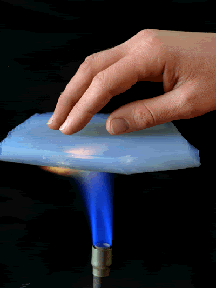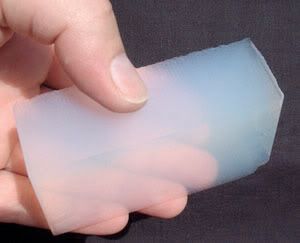99% Gas
No, not a piece on the Democratic Party
Protechs from heat at 2372-degrees Fahrenheit, it stopped a 2-lb dynamite blast, it can soak up the worse of oil spills, and allowed a person to turn his thermostat down 5-degrees. My son and I got to see this at a JPL tour. Wild stuff. I am here posting the whole article here for the NASA/JPL science buffs. I do want to give WorldNet Daily props for this link. I will put photos throughout.
Scientists hail ‘frozen smoke’ as material that will change world
Abul Taher
A MIRACLE material for the 21st century could protect your home against bomb blasts, mop up oil spillages and even help man to fly to Mars.
Aerogel, one of the world’s lightest solids, can withstand a direct blast of 1kg of dynamite and protect against heat from a blowtorch at more than 1,300C.
Scientists are working to discover new applications for the substance, ranging from the next generation of tennis rackets to super-insulated space suits for a manned mission to Mars.
It is expected to rank alongside wonder products from previous generations such as Bakelite in the 1930s, carbon fibre in the 1980s and silicone in the 1990s. Mercouri Kanatzidis, a chemistry professor at
Aerogel is nicknamed “frozen smoke” and is made by extracting water from a silica gel, then replacing it with gas such as carbon dioxide. The result is a substance that is capable of insulating against extreme temperatures and of absorbing pollutants such as crude oil.
It was invented by an American chemist for a bet in 1931, but early versions were so brittle and costly that it was largely consigned to laboratories. It was not until a decade ago that Nasa started taking an interest in the substance and putting it to a more practical use.
In 1999 the space agency fitted its Stardust space probe with a mitt packed full of aerogel to catch the dust from a comet’s tail. It returned with a rich collection of samples last year.
In 2002 Aspen Aerogel, a company created by Nasa, produced a stronger and more flexible version of the gel. It is now being used to develop an insulated lining in space suits for the first manned mission to Mars, scheduled for 2018.
Mark Krajewski, a senior scientist at the company, believes that an 18mm layer of aerogel will be sufficient to protect astronauts from temperatures as low as -130C. “It is the greatest insulator we’ve ever seen,” he said.
Aerogel is also being tested for future bombproof housing and armour for military vehicles. In the laboratory, a metal plate coated in 6mm of aerogel was left almost unscathed by a direct dynamite blast.
It also has green credentials. Aerogel is described by scientists as the “ultimate sponge”, with millions of tiny pores on its surface making it ideal for absorbing pollutants in water.
Kanatzidis has created a new version of aerogel designed to mop up lead and mercury from water. Other versions are designed to absorb oil spills.
He is optimistic that it could be used to deal with environmental catastrophes such as the Sea Empress spillage in 1996, when 72,000 tons of crude oil were released off the coast of
Aerogel is also being used for everyday applications. Dunlop, the sports equipment company, has developed a range of squash and tennis rackets strengthened with aerogel, which are said to deliver more power.
Earlier this year Bob Stoker, 66, from
Mountain climbers are also converts. Last year Anne Parmenter, a British mountaineer, climbed Everest using boots that had aerogel insoles, as well as sleeping bags padded with the material. She said at the time: “The only problem I had was that my feet were too hot, which is a great problem to have as a mountaineer.”
However, it has failed to convince the fashion world. Hugo Boss created a line of winter jackets out of the material but had to withdraw them after complaints that they were too hot.
Although aerogel is classed as a solid, 99% of the substance is made up of gas, which gives it a cloudy appearance.
Scientists say that because it has so many millions of pores and ridges, if one cubic centimetre of aerogel were unravelled it would fill an area the size of a football field.
Its nano-sized pores can not only collect pollutants like a sponge but they also act as air pockets.
Researchers believe that some versions of aerogel which are made from platinum can be used to speed up the production of hydrogen. As a result, aerogel can be used to make hydrogen-based fuels.




